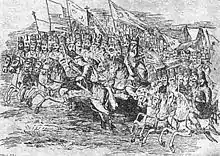Serbian national identity
Serbia is the nation state of the Serbs, who are Serbia's dominant ethnic group. Serbs are also dominant in Republika Srpska, an entity of Bosnia and Herzegovina. In the 19th century, the Serbian national identity was manifested, with awareness of history and tradition, medieval heritage, cultural unity, despite Serbs living under different empires. Three elements, together with the legacy of the Nemanjić dynasty, were crucial in forging identity and preservation during foreign domination: the Serbian Orthodox Church, Kosovo Myth, and the Serbian language.[1] The identification with medieval heritage through venerating Serbian saints, together with Serbian epic poetry, had helped develop a national consciousness separate from other Orthodox peoples in the Balkans.[2] The heroic epic cycles inspired the Serbs to revive their heroic past and freedom.[2] In the stories, the hajduks were heroes: they had played the role of the Serbian elite during Ottoman rule, they had defended the Serbs against Ottoman oppression, and prepared for the national liberation and contributed to it in the Serbian Revolution.[3] The symbolical Kosovo Myth became the mythomoteur, signifying martyrdom and defence of Serb honour and Christendom against Turks (Muslims).[4] When the Principality of Serbia gained independence from the Ottoman Empire, Orthodoxy became crucial in defining the national identity, instead of language which was shared by other South Slavs (Croats and Muslims).[5]

The Kosovo Myth views the Serbs as martyrs and defenders of honour and Christianity.
The Cyrillic script is an important symbol of Serbian identity.[6] Under the Constitution of Serbia of 2006, Serbian Cyrillic is the only script in official use;[7] it is also co-official in Montenegro and Bosnia and Herzegovina.[8] The double-headed eagle and the shield with fire steels are the main heraldic symbols which have represented the national identity of the Serbian people across the centuries.[9]
An international self-esteem survey conducted on 16,998 people from 53 nations was published by the American Psychological Association in 2005;[10] the questionnaire included views of one's individual personality, that of one's own nation and that of other nations. The research found that Serbia was placed first of the most self-esteemed nation, ahead of the United States (6th), and Japan (last place), and the majority of nations, as well as Serbs themselves, agreed on this.[11] The research also noted that Serbia was among the 10 most collectivist nations.[10]
References
- Ana S. Trbovich (2008). A Legal Geography of Yugoslavia's Disintegration. Oxford University Press, USA. pp. 69–. ISBN 978-0-19-533343-5.
- Alex N. Dragnich (1994). Serbia's Historical Heritage. East European Monographs. pp. 29–30. ISBN 978-0-88033-244-6.
- Edited by Norman M. Naimarkand Holly Case; Norman M. Naimark (2003). Yugoslavia and Its Historians: Understanding the Balkan Wars of the 1990s. Stanford University Press. pp. 25–. ISBN 978-0-8047-8029-2.CS1 maint: extra text: authors list (link)
- Stoianovich, Traian (1 January 1994). Balkan Worlds: The First and Last Europe. M.E. Sharpe. p. 303. ISBN 978-0-7656-3851-9.
- Christopher Catherwood (1 January 2002). Why the Nations Rage: Killing in the Name of God. Rowman & Littlefield. pp. 135–. ISBN 978-0-7425-0090-7.
- Entangled Histories of the Balkans: Volume One: National Ideologies and Language Policies. BRILL. 13 June 2013. pp. 414–. ISBN 978-90-04-25076-5.
- Article 10 of the Constitution of the Republic of Serbia (English version Archived 2011-03-14 at the Wayback Machine)
- Ronelle Alexander (15 August 2006). Bosnian, Croatian, Serbian, a Grammar: With Sociolinguistic Commentary. Univ of Wisconsin Press. pp. 1–2. ISBN 978-0-299-21193-6.
- Atlagić, Marko (2009). "Određivanje nacionalnih heraldičkih simbola na primjeru Srba i Hrvata [Étude des symboles nationaux héraldiques à l' exemple des Serbes et des Croates]" (PDF). Zbornik Radova Filozofskog Fakulteta u Prištini, no. 39, pp. 179–188: 180.
- David P. Schmitt; Jüri Allik (2005). "Simultaneous Administration of the Rosenberg Self-Esteem Scale in 53 Nations: Exploring the Universal and Culture-Specific Features of Global Self-Esteem". Journal of Personality and Social Psychology. 89 (4): 623–642. doi:10.1037/0022-3514.89.4.623. PMID 16287423.
- Kurir, Mondo (20 August 2012). "Istraživanje:Srbi narod najhrabriji". B92.
Further reading
- Alexander, Stella (1983). "Religion and national identity in Yugoslavia". Occasional Papers on Religion in Eastern Europe. 3 (1): 2–.
- Budding, Audrey Helfant (1997). "Yugoslavs into Serbs: Serbian national identity, 1961–1971". Nationalities Papers. 25 (3): 407–426. doi:10.1080/00905999708408515.
- Cvetković, Vladimir N. (2002), Nacionalni identitet i (re) konstrukcija institucija u Srbiji (ideologije, obrazovanje, mediji) (PDF)
- Janjić, Dušan (1997). "The Management of Ethnic Conflict and the Crisis of National Identity". Ethnic Conflict Management. The Case of Yugoslavia: 171–193.
- Jovanović, Dejan (2015). "DUALNA PRIRODA SRPSKOG NACIONALNOG IDENTITETA" (PDF). Politički identitet Srbije u globalnom i regionalnom kontekstu. Belgrade: Univerzitet u Beogradu. Fakultet političkih nauka: 55–60.
- Jovanović, Ana Kuzmanović (2011). "Preserving the Integrity of National Identity: Metaphors for Kosovo in Serbian Political Discourse". Texas Linguistics Forum. 54.
- Mylonas, Christos (2003). Serbian Orthodox fundamentals: The quest for an eternal identity. Central European University Press. ISBN 9789639241619.
- Nedeljković, Saša (2006). "Mit, religija i nacionalni identitet: Mitologizacija u Srbiji u periodu nacionalne krize" (PDF). Етноантрополошки проблеми: 155–179.
- Radenović, Sandra (2006). "Nacionalni identitet, etnicitet, (kritička) kultura sećanja". Filozofija I Društvo. 3 (31).
- Miketić, Sanja D.; Baščarević, Ivan M. (2016). "Ćirilica kao obeležje nacionalnog identiteta kod studentske populacije Univerziteta u Prištini sa privremenim sedištem u Kosovskoj Mitrovici". Zbornik Radova Filozofskog Fakulteta u Prištini. 46 (1): 49–65. doi:10.5937/zrffp46-10800.